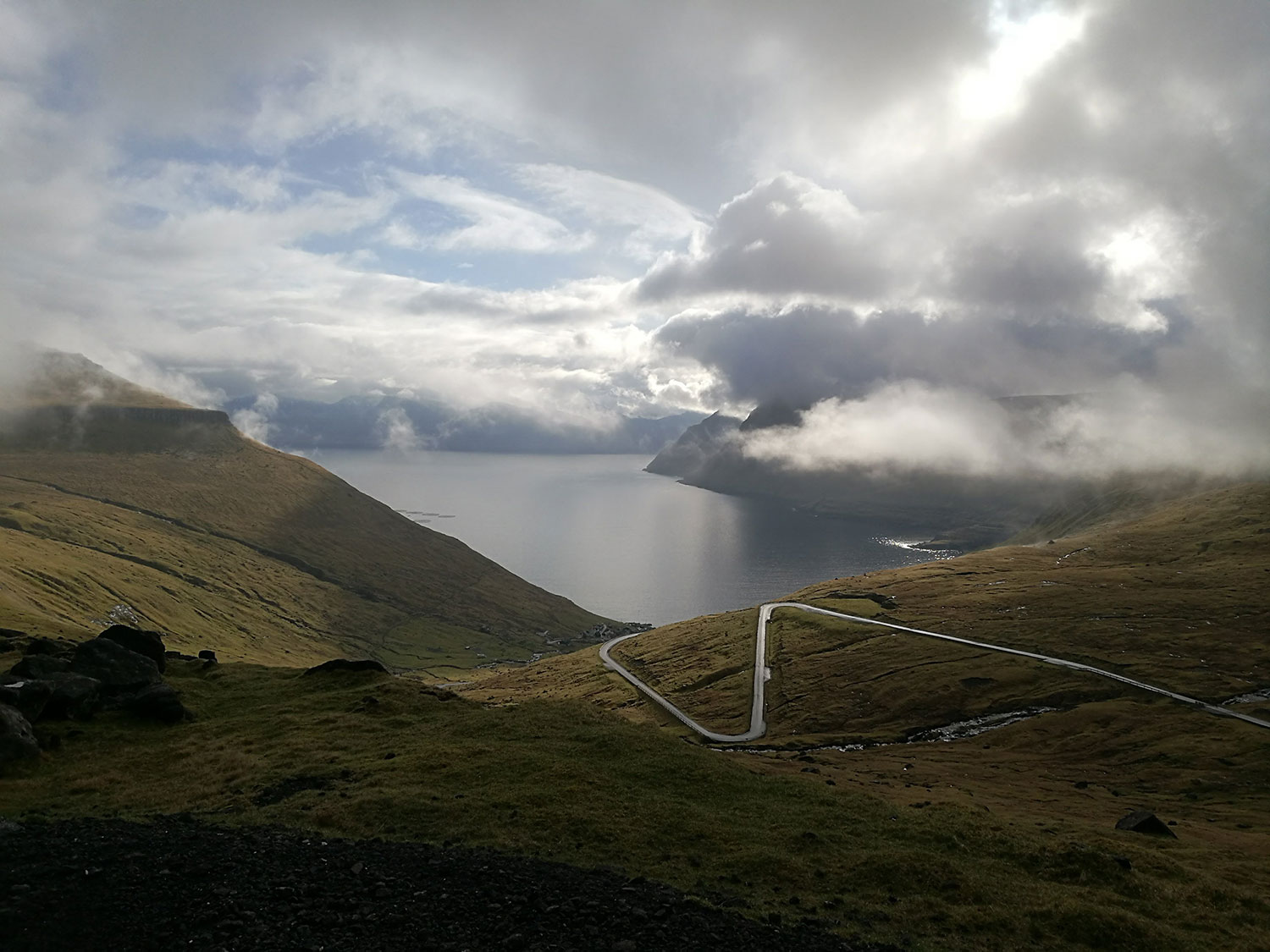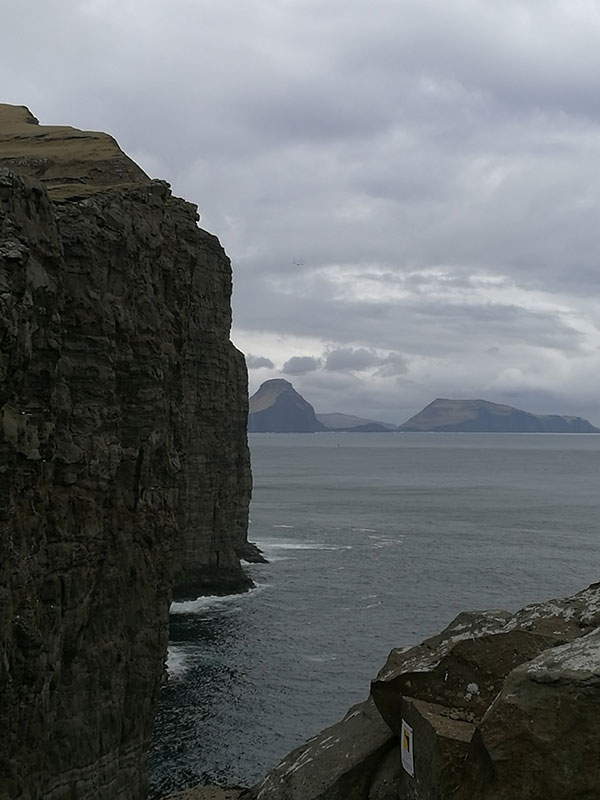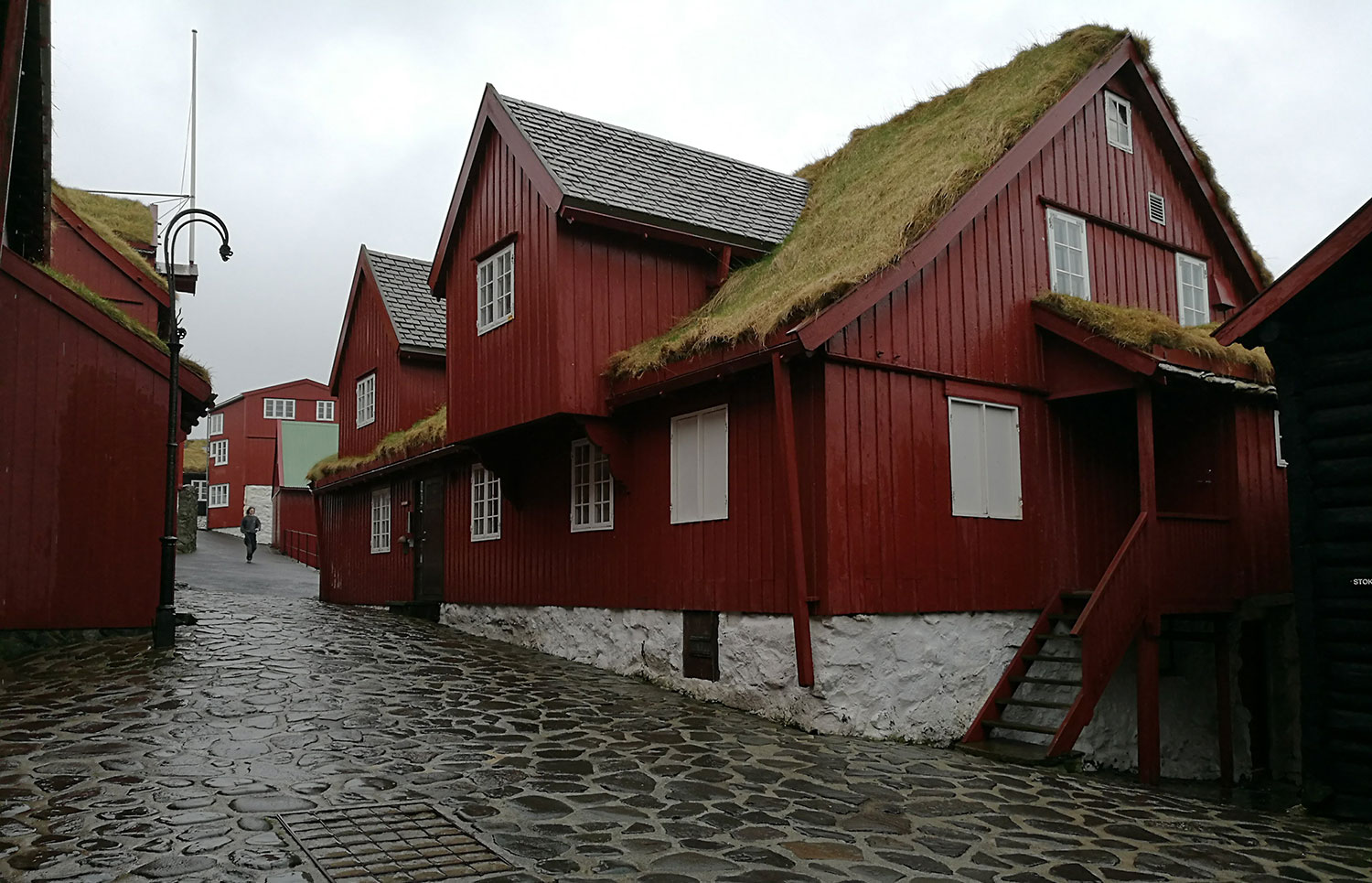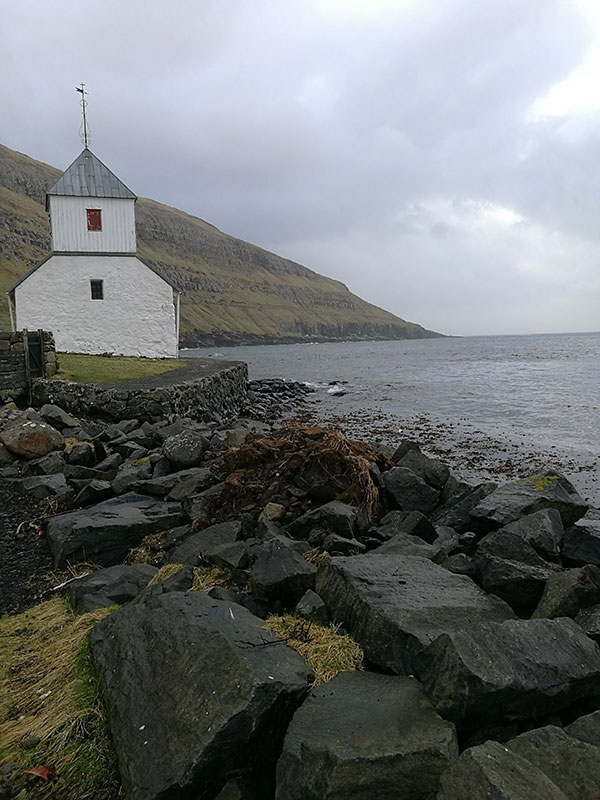
Travel Notes for the Faroe Islands
Written by Jay Courtney
Between Fair Isle and South East Iceland according to the BBC Shipping Forecast, lie Faeroes, or the Faroe Islands as they prefer to be known. A group of 18 islands fashioned in the shape of an axe-head. Sometimes they appear on maps, often-times not. The Faroe Island’s only airport is at Vágar, which seemed aptly named as I landed in thick fog. Built by the British Air Force during their ‘friendly’ invasion in 1940, it still has the feel of a small military outpost. The hotel at the airport has good facilities and is a useful stop before sailing (or flying) to the bird island Mykines.
If you travel light, it is possible to walk straight out of the airport, head towards Midvagar and take the path on the right alongside Lake Sørvágsvatn (called locally Vatnio) and get your first experience of the magnificent Faroes (troll fingers and all). Alternatively, turn left and walk the one kilometre down to Sørvágu (ferry to Mykines) which has a few shops and a small beach.

Tórshavn
Tórshavn is a delight. I was travelling out of season and so whereas the old town Reyn would usually have been thronging in the summer months, I had it all to myself. It had the feel of a full-sized model village. Large red and black tarred houses with white windows and green grass roofs huddled together in cobbled streets. Tinganes is one of the oldest parliaments and courts in the world dating from approximately 825AD. Walking into town from Reyn I was spoilt for choice of coffee shops as refuge from squally weather. Faroese knits and textiles are plentiful, and most travellers’ needs can be met in the town (often Danish and expensive), including from the sportswear shop ‘Athlete’s Foot’. On the quayside ‘Öström’, the old fish oil factory is worth a detour; local art, recycled artefacts and designer clothes made from salmon skin ‘leather’.
Wild Parties
Islanders make up for the long winter by partying all summer long. On the more remote islands locals take the opportunity to visit friends and relatives, often by subsidised helicopter. Every town and many villages have festivals with local, traditional themes, such as the Faroese chain dance, but many also attract singers and bands from all over the world: everything from blues to heavy rock, folk to pop. There is a different festival almost every week through the summer (www.visitfaroeislands.com/about/art-culture-sport/music/)
Wild Walking
Walkers and birdwatchers are in for a treat. There are majestic and magnificent walks everywhere, even straight out of the airport and town centres. Sheep outnumber people two to one. It’s very easy to stroll up the top of a vertiginous cliff and look a kittiwake in the eye, but do take care, it’s very easy to fall off, and it does happen. Footpaths are generally unmarked and hiking guide books are quite loose in their descriptions. It’s hard to follow instructions to the ‘cairn at the top of the hill’ in thick fog and even harder to find your way down safely. The weather changes rapidly, so sitting it out for a bit can be the safest option, unless of course night is about to fall. The weather was not kind to me during my stay, but I still managed these hikes:
Fuglafjørður - Hullurnar

This path known as Sjurdargota is littered with epic stories about fights with giants, rock tossing competitions with pregnant milkmaids and warring neighbours. The views make the climb to the top of Skardid, well worth it. Once at the top, it’s important to throw three small stones ‘In the name of the father, and of the son and of the holy spirit’ to bless the trip and stop you from getting lost. Even in my atheist state, it worked for me!
Lake Sørvágsvatn/Leitisvatn (Known locally as Vatnio ‘the water’)
A kilometre or so west of Miðvágur, along route 40 look out for some boat huts and park in the layby at the northern end of the largest lake in the Faroes. This makes a great hike (12 k return) if you are walking solo and having a bad-weather day. Take care at the most southerly point Trælanípa not to go the way of slaves past their usefulness, pushed off the top during Viking times. The cliff falls away vertically from a height of 142m. If the weather is safe enough to gain height, you’ll see the Bøsdalafossur waterfall where the lake tumbles into the sea.
Kirkjubøur to Tórshavn
Stand facing the village in Kirkjubøur and you will likely hear Eider Ducks gossiping about you behind your back. It would be hard not to be overwhelmed by both the size and presence of Magnus Cathedral. At 27m long and 11 m wide it seems incongruous in such a remote place and yet its immense structure sits well in the equally vast and rugged landscape. Look out for the bricked-up hole in the northern wall where lepers could listen to the service but not enter the church. There’s a small ‘living’ museum next to the Roykstovan farmhouse which gives a real feel of Faroese life up until relatively recently. It’s worth setting off on the footpath to Tórshavn (7km) even if you don’t intend to do the whole thing. The views towards the small Islands of Koltur and Hestur with Vágar beyond were captivating. Along the path are two small lakes teaming with Kittiwakes and before you a panoramic view of Tórshavn and the island of Nólsoy.
Wild Food
Traditionally the Faroese ate fresh fish and lamb in summer together with meadow herbs. All around the island you will see fish and meat being air-dried beneath house porches to provide sustenance during the long winter months. Eating was a necessity, not an art, but that is changing. Skerpikjøt, or fermented lamb, is a local delicacy enjoyed everywhere, but perhaps not so readily by tourists. Few vegetables, except potatoes and turnip, will grow in such challenging conditions and rhubarb is the only fruit to grow. Fortunately, I like rhubarb as it was served in almost all desserts. All other fresh foodstuffs are flown in, so expect to pay a premium. The ‘New Nordic’ cuisine is evident in Tórshavn, with some excellent restaurants; ‘Frumbiti’ next to Hotel Havn was outstanding. ‘Koks’ at Leynavatn gained the islands first Michelin Star with its 17-course tasting menu. Föroya Bjór is brewed on Borðoy Island at Klaksvík and has a unique twist of Faroese rhubarb, angelica and other herbs.
Vital Statistics
Capital: Tórshavn (Smallest Capital City in the World)
Population: 49,000
Language: Faroese, Danish. English is widely understood
Time: GMT winter, GMT +1 Summer
International Dialling Code; +298
Visa: Not required for UK travellers
Money: Faroese Krona/Danish Krone
When to Go
The Faroes sit in the stormiest part of the North Atlantic. Expect a lot of weather. Many attractions and transport routes are only available in the summer months May-August. Check availability for other months.
| Jan | Feb | Mar | |
|
Ave rainfall (mm) |
22 |
18 | 21 |
| Ave temp (C) | 2-6 | 2-6 | 2-6 |
| April | May | June | |
| Ave rainfall (mm | 16 | 12 | 10 |
| Ave temp (C) | 3-7 | 5-9 | 7-11 |
| July | Aug | Sep | |
| Ave rainfall (mm | 13 | 13 | 18 |
| Ave temp (C) | 9-13 | 9-13 | 8-12 |
| Oct | Nov | Dec | |
| Ave rainfall (mm | 21 | 20 | 22 |
| Ave temp (C) | 6-9 | 3-7 | 2-6 |
Health and Safety
In terms of crime, the Faroes are one of the safest places on earth. Health care is excellent. Emergency care is free (you will need to present your passport), other treatment must be paid for, so make sure you have good travel insurance. The greatest risk comes from the land itself, precipitous cliffs with rapidly changing weather including dense fog can make even a gentle stroll dangerous. Take local advice and hire a guide if possible.
Women Travellers: are unlikely to encounter any problems
LGBT Travellers: Despite being a very religious country LGBT travellers are likely to be made very welcome. Remarkably over ten per cent of the population turn out for Faroe Pride on July 27th.
Further reading
Bradt: A Cruising Guide Wildlife of the North Atlantic, Tony Soper.
Bradt. Faroe Islands, James Proctor.
Getting there
Atlantic Airways (https://www.atlanticairways.com/en). +298341000
Flights from Edinburgh to Vágar, Vágar Island. From 29th March 2019 until Christmas, every Tuesday and Friday. No flights between January and March.
Getting Around
In summer (May - August) public transport via bus, ferry, even helicopter, is frequent. Even so, many places of interest are remote and car
hire is needed (essential in winter unless you centre in Tórshavn). There are several car hire companies at the airport: 62N www.62n.fo or AVIS info@avis.fo also on each of the bigger islands
Cost of Travel
The Faroes can be expensive as most items are imported. Allow for tolls in sub-sea tunnels.
Accommodation
Hostel Giljanes http://www.giljanes.fo Double Room 450DKK (£51). Basic hostel accommodation, but what a view!
Hotel Havn https://www.62n.fo Double Room in summer 1495 DKK (£171). Clean scandi-style, more like a hostel than a hotel. Convenient for walking into Tórshavn and driving out to sights. (Use the nearby public car park)
Hotel Føroyar https://hotelforoyar.fo Double rm 1801 DKK (£206) Closer to a luxury hotel, atmospheric with great loch views, food and
parking. A mile outside of Tórshavn.
Guesthouse Gjáargarður www.gjaargardur.fo, Eysturoy Island. Double Rm DKK 1250 (£160) My favourite; beautiful setting with views to Kalsoy, walk straight out the door to stupendous cliffs alive with Kittiwakes. Evening dinner is basic but wholesome. Worth it for the hair-raising drive there via hairpin bends with sheer drops and “top-of-the-world” views. Delightful Village (Café in summer). Wild, stony bay for contemplation and birdwatching. Gorgeous gorge, Gjogv
Food and Drink
Expect a wide choice of international food inTórshavn. The more remote islands and towns often have very limited choice and may be closed on Sundays. Few places of interest have on-site cafes so it's worth taking a flask and snack with you.
Favourite restaurant Frumbiti https://www.frumbiti.fo Great modern, local food. Outstanding fish, passionate staff. Not cheap but excellent quality.
Favourite Coffee shop: Paname Great coffee, cakes, free wi-fi and bookshop (some English Language) all rolled in one.
Tagged under: Travel

